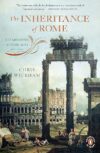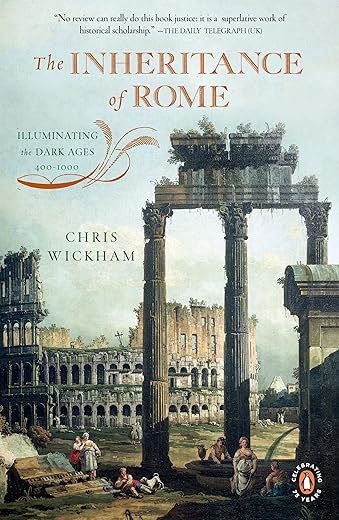
$10.80
The Inheritance Of Rome Price comparison
The Inheritance Of Rome Price History
The Inheritance Of Rome Description
The Inheritance Of Rome: A Comprehensive Exploration of Medieval History
Discover the rich history of Medieval Europe with The Inheritance Of Rome. Published by Penguin Books on July 18, 2009, this extensive work is a must-read for history enthusiasts and scholars alike. Spanning 664 pages, this book delves into the complexities of the Middle Ages, analyzing political, social, and cultural developments that shaped Europe. Whether you are a student of history or simply curious about the past, this engaging narrative will captivate your attention.
Main Features That Make The Inheritance Of Rome Stand Out
- Comprehensive Content: The Inheritance Of Rome covers critical events and themes across the early medieval period, making it an excellent resource for understanding the European landscape during this time.
- Publisher Quality: Published by Penguin Books, a renowned name in publishing, ensuring high-quality content vetted by experts in the field.
- Accessibility: The book features enhanced typesetting and supports screen readers, making it accessible to a broader audience. Text-to-Speech capabilities allow for a seamless listening experience.
- Well-Approved Format: With a file size of 14992 KB, The Inheritance Of Rome is designed for easy access on various digital devices, offering flexibility for modern readers.
- Engaging Narrative: The author presents historical facts in an entertaining manner, connecting events and personalities that defined an era.
- Backed by Research: A substantial bibliography and references ensure that readers can trust the information presented and explore further reading.
Price Comparison Across Different Retailers
When considering The Inheritance Of Rome, it’s crucial to find the best deal. Prices for this book may vary across online retailers. Our price comparison tool will help you discover the best options tailored to your budget. For instance, Amazon frequently offers competitive pricing, alongside paperback editions available through various sellers. Regularly checking prices can help you secure an attractive deal, especially during sales events.
Insights from the 6-Month Price History Chart
Our detailed analysis of the 6-month price history chart reveals notable trends for The Inheritance Of Rome. Over this time, prices have generally trended downwards, with particular discounts appearing in the lead-up to holidays or back-to-school sales. This trend suggests that if you’re patient, you might snag a better price as promotions roll out. Monitor the chart closely to catch the best offers!
Customer Reviews: Positive Aspects and Noted Drawbacks
Customer feedback for The Inheritance Of Rome generally highlights its insightful narrative and depth of information. Many readers praise the author’s ability to weave stories that breathe life into historical facts, making complex subjects engaging. The accessible writing style allows both novices and experienced history buffs to grasp the material effortlessly.
However, some reviewers have noted areas for improvement. A few readers found certain sections dense with information, occasionally overwhelming their understanding. Additionally, the book’s length may deter casual readers looking for a breezier read.
Explore Related Unboxing and Review Videos
To enhance your understanding of The Inheritance Of Rome, consider exploring unboxing and review videos on platforms like YouTube. These videos provide visual insights into the book’s content, layout, and overall quality. Watching an unboxing can help potential buyers make informed decisions and appreciate the book’s physical attributes before purchasing.
If you’re eager to dive into the intricate details of Medieval Europe, The Inheritance Of Rome is definitely worth adding to your collection. It combines thoughtful analysis with engaging storytelling, providing readers with a profound understanding of the era.
Ready to start your historical journey? Take the first step! Compare prices now and secure your copy of The Inheritance Of Rome today!
The Inheritance Of Rome Specification
Specification: The Inheritance Of Rome
|
The Inheritance Of Rome Reviews (7)
7 reviews for The Inheritance Of Rome
Only logged in customers who have purchased this product may leave a review.













Carl Gershenson –
The period 400-1000 is a blank spot in the minds of most people, even for those who know a great deal about Rome and medieval Europe. What we do tend to know are a handful of decontextualized names (e.g. Charlemagne) and some stock images of bearded men in leather armor killing each other. Wickham, then, was faced with a formidable task: not just to introduce his readers to the Ostrogoths, the Merovingian kingdom, etc., but also to disabuse us of popularly held notions, like the precipitous fall of Rome in 476 or the discontinuities between Rome and its ‘barbarian’ successor states.
It’s for this reason that I strongly disagree with the reviews complaining that this book has too many details, and should not have been marketed to a general audience. The many details are not the intended “takeaway” of this book. Rather, Wickham presents us with such rich anecdotes so that long after the names and events vanish from memory, readers will be left with a deep (and accurate) feel for post-Roman culture, society, and government. Given how shallow (and inaccurate) my feel for post-Roman Europe was before reading Wickham’s book, I consider his book extremely effective.
On the dust jacket, a reviewer describes Wickham’s writing as “pointillist.” I think this description is apt. As with pointillist paintings, this work’s intent can only be comprehended after you take a step back from the anecdotes. Wickham’s prose is only difficult if you get too worried about remembering that Sidonius Apollinaris was so-and-so’s son-in-law, lived in Clermont in the 5th century, etc. General readers need not worry about the details – Just keep on reading, and be confident that you will finish the book with a different understanding of 400-1000 AD than when you started.
S. Silvestre –
This book is a dense and comprehensive review of the history of medieval Europe, starting from the transition from the Roman Empire to the medieval era. It is a very good book.
Kristi Howard –
Chris Wickham is possibly the best medievalists in the world today, so it would be presumptive to comment on the contents. So I confine my remarks to the use.
I suggest that you read the whole book through “to get the feeling” of the age. There is so much detail that you will only retain a portion of what you have read. Now comes the hard work: read the book with you computer to look up details of what you have read. This can be both pleasurable and instructive.
Then keep the book as a superb reference item.
This book is an essential item for any historian who wants a deep understanding of the age, and wants to enjoy the study.
Cliente Amazon –
Wickham apresenta um olhar maduro para a Idade Média, revelando tensões e uma estrutura complexa que vai além de uma história plana e hegemônica. Ao problematizar pequenas estruturas e outros grupos sociais Wickham dá mais densidade a compreensão política e econômica medievais.
Don Calavera –
El libro cubre el periodo entre la caída del Imperio Romano de Occidente y el inicio de la baja Edad Media, es un ensayo excelente aunque quizá la prosa no es la mejor si no tienen ciertos conocimientos previos sobre el periodo.
Cliente Amazon –
Not easy to read, the book offers an excellent summary and updated analysis of some of the most o scure centuries of Europe’s history. Probably the best study on the period.
Greg Polansky –
First of all, let’s start with the title. The Dark Ages are an outdated term for a period that was anything but dark. The title used in England of this book, The Inheritance of Rome: A History of Europe from 400 to 1000, is a better guide to what you will be getting in this book. Even then, that too is misleading since areas like North Africa and what is now Iraq get coverage. Chris Wickham details the history of both the lands that Rome held sway over and lands at the periphery of the Roman Empire. For anyone always annoyed by the incorrect factoid that the Roman Empire fell in 476 CE, this will be good news.
Wickham does an excellent job of recounting the transformation of the Western Roman Empire, an area urbanized where the public sphere was important, into the subsequent kingdoms that were highly militarized, and where the public sphere had atrophied because cities were no longer possible to maintain in the first part of the period. Thus we get excellent histories of Vandal Africa, Visigothic Spain, Burgundy, Ostrogothic then Lombard Italy, Merovingian Francia, and later on of both the Carolignian Empire and the Caliphate that took over most of Iberia. Wickham details political and economic history extremely well, social history moderately well, and cultural history not as well. His analysis of the transformation of the area in late antiquity is extremely well done and a highlight of the book. In particular, the focus on the conquest of Africa by the Vandals in 439 is an interesting idea. This was the source of food for a huge swath of the Western Empire, and the conquest was a turning point in Roman history.
The second main focus for Wickham is the Eastern Roman Empire/Byzantine Empire. Again, there is some good analysis, especially on the significance of the conquest of Egypt and what it entailed for Constantinople. As I love Byzantine history, I was happy to see this discussed at more length than usual, though not as well as some other authors have done. The period on Justinian really could have been done better. If you’re interested in Byzantine history, I really do recommend John Julius Norwich’s magisterial trilogy.
The third main focus is on the Muslim lands that were conquered in the 7th and 8th centuries. Strangely enough, Wickham does a better job for these areas than he does for the Byzantine Empire. The section on Baghdad was a particular high point.
Lastly, and sort of added as a ‘oh hey, I may as well add more to this book’ are discussions of the periphery – Anglo-Saxon England, Scotland, Ireland, Scandinavia, and some not great sections on the Slavic lands and other parts of what we now call East Europe,
If you’re interested in the latest developments in medieval history, this is a good book to start from. It’s not always the easiest to read, but it is rewarding. And the focus on non-Western Europe in addition to Western Europe is a welcome addition. There are insightful ideas all throughout the book – for instance, often histories claim these are the Dark Ages, but Wickham shows that even in the West at least the aristocratic members of society were still able to read as late as the end of the ninth century. Most importantly is the idea of looking at these areas on their own terms and not judging the period through lens of Renaissance revisionists.